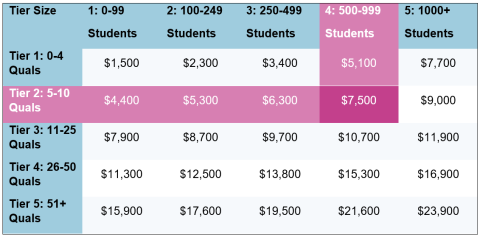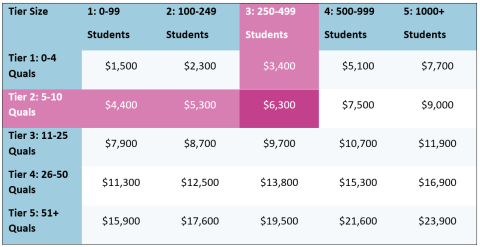- Home
- About us
- Fees and charges
- Annual registration charge
Annual registration charge
What is the RTO annual registration charge?
The Annual Registration Charge (ARC) recovers costs generated through ASQA’s sector- wide regulatory activity. It is an annual charge paid by all VET and ASQA regulated ESOS providers.
Why is an annual registration charge necessary?
ASQA’s regulation of risks to quality Vocational Education and Training (VET) safeguards an effective market for providers of VET and course owners: it is important to students, employers in all sectors of the economy and the economy itself. This regulatory activity generates costs: efficient, effective regulatory activity translates to minimum efficient cost of the regulator.
The purpose of the ARC as a cost recovery mechanism is not changing from 2022-23; nor is the scope. From July 2022, all VET and ESOS providers will continue to pay an ARC.
From 1 July 2022 ASQA is required to fully recover costs for the majority of its regulatory activities in accordance with the Australian Government Charging Framework and Cost Recovery Guidelines (AGCRG). Fee Relief announced in April 2020 has been extended for ELICOS only providers until 31 December 2022.
Costs of ASQA’s regulatory activity are estimated before the beginning of each financial year, using a best practice cost recovery model, which is independently assured.
What does the annual registration charge cover?
The ARC recovers costs that are generated through regulatory activity that applies to the whole sector (not directed to a specific provider) including:
- Advisory Council and regulatory governance
- Service delivery
- Regulatory education
- Regulatory intelligence
- Regulatory policy and design
- Regulatory risk and assurance
- Regulatory stakeholder engagement and communication
- Regulatory reporting
- Regulatory support
- Monitor compliance with service standards.
For more information about what is covered in the ARC, refer to '4.5 Sector-wide regulatory charge - annual registration charge for providers’ of ASQA’s Cost Recovery Implementation Statement 2022-23.
How is the annual registration charge calculated?
The CRIS Section 4.5 sets out ASQA’s approach to calculating the ARC. The ARC is calculated using the dual metrics of:
1. The total number of qualifications and courses on a provider’s scope as at 1 July each year
The total number of qualifications and courses on a provider’s scope as at 1 July each year.
- Qualifications = A training product listed as a qualification on a provider’s scope on the National Register
- Courses = A training product listed as an accredited course on a provider’s scope on the National Register.
Notes:
- Training products listed as individual units of competency and skill sets on the National Register are not counted as a qualification for the purposes of the ARC calculation.
- Where a superseded non-equivalent or deleted training product remains on a provider’s scope, they will be counted as a qualification. If the superseded product is equivalent to another version the provider has on scope, these will be counted as one product.
2. The number of unique students enrolled by a provider in the preceding calendar year
The total number of unique students enrolled in a qualification, course or skill set in a calendar year, as reported by each provider in accordance with their AVETMISS reporting requirements.
- Unique student = A student will only be counted once where they have been enrolled in multiple qualifications, courses and skill sets in a calendar year
- Qualification = a training product listed as a qualification on a provider’s scope on the National Register
- Course = a training product listed as an accredited course on a provider’s scope on the National Register
- Skill set = A nationally accredited skill set listed in an accredited training package (for example HLTSS00068 - Occupational First Aid Skill Set)
- Calendar year = The period January to December of the previous year.
Note:
- Students enrolled in individual units of competency, not leading to a qualification, accredited course or skill set, are not counted as a “student” for the purposes of the ARC calculation.
Each of these metrics are broken into five tiers, to ensure that the ARC reflects the demand created by an entity's requirement for ASQA’s regulatory work and services.
ASQA uses these dual metrics to calculate the charge payable against the scale outlined in the table below.
| Tier size |
0-99 Students |
100-249 Students |
250-499 Students |
500-999 Students |
1000+ Students |
|---|---|---|---|---|---|
| 0-4 Quals | $1,500 | $2,300 | $3,400 | $5,100 | $7,700 |
| 5-10 Quals | $4,400 | $5,300 | $6,300 | $7,500 | $9,000 |
| 11-25 Quals | $7,900 | $8,700 | $9,700 | $10,700 | $11,900 |
| 26-50 Quals | $11,300 | $12,500 | $13,800 | $15,300 | $16,900 |
| 51+ Quals | $15,900 | $17,600 | $19,500 | $21,600 | $23,900 |
Case studies
You might like to refer to the following case studies to help you further understand how the charge is calculated:
The International Study Association Ltd is a VET and ESOS registered provider.
It has 5 ESOS registered VET courses on its scope of registration on CRICOS as at 1 July:
- SIT30816 - Certificate III in Commercial Cookery
- SIT40516 - Certificate IV in Commercial Cookery
- CHC32015 - Certificate III in Community Services
- CHC33015 - Certificate III in Individual Support
- CHC43015 - Certificate IV in Ageing Support
The provider enrolled 680 students during the previous calendar year.
- 240 students in SIT30816 - Certificate III in Commercial Cookery
- 180 students in SIT40516 - Certificate IV in Commercial Cookery
- 150 students in CHC33015 - Certificate III in Individual Support
- 110 students in CHC43015 - Certificate IV in Ageing Support
Of these students, only 510 are unique students as 170 students were enrolled in two qualifications in the previous calendar year.
Using these two metrics the provider sits in tier 4 for the number of students and tier 2 for the number of qualifications.

Using the Annual Registration Charge (ARC) scale the ARC payable will be $7500 and will be invoiced in July.
Community Care RTO Pty Ltd is a not-for-profit provider, offering courses and qualifications. It has 3 qualifications, 2 accredited courses and 3 units of competency on their explicit scope of registration as at 1 July:
- BSB30120 - Certificate III in Business
- BSB20120 - Certificate II in Workplace Skills
- FSK10219 - Certificate I in Skills for Vocational Pathways
- 10984NAT - Certificate II in Basic English for Speakers of Other Languages
- 10704NAT - Certificate II in Basic Aboriginal Languages for Social Use
- HLTAID009 - Provide cardiopulmonary resuscitation
- HLTAID010 - Provide basic emergency life support
- HLTAID011 - Provide First Aid.
In the last calendar year, it enrolled 1190 students in the above training products.
- 30 students in BSB30120 - Certificate III in Business
- 65 students in BSB20120 - Certificate II in Workplace Skills
- 75 students in FSK10219 - Certificate I in Skills for Vocational Pathways
- 75 students in 10984NAT - Certificate II in Basic English for Speakers of Other Languages
- 45 students in 10704NAT - Certificate II in Basic Aboriginal Languages for Social Use
- 300 students in HLTAID009 - Provide cardiopulmonary resuscitation
- 300 students in HLTAID010 - Provide basic emergency life support
- 300 students in HLTAID011 - Provide First Aid.
To calculate the ARC for this provider, it is determined to sit in tier 2 for qualifications and tier 3 for number of students as:
- Units of competency explicitly listed on a provider’s scope of registration are not counted as a qualification for the purposes of the ARC calculation
- Students enrolled in individual units of competency not leading to a qualification, accredited course or skill set, are not counted as a “student” for the purposes of the ARC calculation.

Using the Annual Registration Charge (ARC) scale the ARC payable will be $6,300 and will be invoiced in July.
Frequently asked questions
| Date | Event |
|---|---|
| Previous calendar year | Provider as part of AVETMISS requirements records student enrolments. |
| February | Provider or funding authority submits AVETMISS data to NCVER. |
| 30 June each year | ASQA reviews the number of qualifications on a provider’s scope of registration. |
| July each year | ASQA sends out invoices for the RTO’s ARC. |
In November 2019, ASQA’s Fees and Charges Proposal 2020-21 Consultation Paper proposed that all providers receive a single ARC invoice, removing the requirement for ESOS providers to pay two separate annual registration charges.
This measure received support through ASQA’s stakeholder engagement initiatives in 2019, 2021 and 2022 and has been implemented for the 2022-2023 ARC.
It is expected that the changes will:
- simplify the processes of invoicing, pursuing payments, and processing payments received - resulting in efficiencies that benefit ASQA, ASQA-regulated entities, and other VET sector stakeholders
- increase transparency for current and prospective training providers of the annual cost of maintaining registration as an RTO and/or ESOS provider.
The Fee relief announced in April 2020 has been extended for ELICOS only providers until 31 December 2022.
ELICOS only providers will be allocated to the tier 1 for qualifications (0-4 Quals), and tier 1 for students (0-99 Students) for the purposes of calculating the ARC.
This is commensurate with the complexity and scope of ELICOS only providers relative to other providers.
ELICOS only providers will receive an invoice in July 2023 for the 2023-24 ARC.
The following arrangements apply to providers who are registered for less than a full financial year:
- Registration withdrawn, cancelled, or expired due to non-renewal
Where an NVR registered training organisation or registered provider’s registration ends during a billing period (i.e. registration is withdrawn, cancelled, or expired due to non-renewal), only a pro-rata charge applies for the number of whole months of registration. Where an excess amount is paid the amount refundable is for the number of whole months remaining in the financial year after the registration ends.
- Providers in their first year of operations
For RTOs that become an NVR registered training organisation for the first time (i.e. are not renewing their registration), the annual charge is calculated based on the number of qualifications on the providers scope of registration and the first tier of student scale (0-99 students).
The calculation then uses the following formula A x B / 12.
Where:
- “A” is the amount of annual registration charge and
- “B” is the number of full months that remain up to 30 June after the RTO becomes registered as an NVR registered training organisation.
The Department of Education (previously DESE) also has its own separate regulatory accountability for ESOS providers which is different from the regulatory work of ASQA. The Department may charge ESOS providers for the Department’s regulatory activities. For more information about the Department’s regulation of ESOS providers and any fees and charges administered by the Department, please refer to the Department’s annual registration charge page.
If the superseded product is not equivalent to its replacement, then yes, it will count as a qualification when calculating your annual registration charge, in addition to the current version. If the replacement product is equivalent, the 2 products will be counted as one.
In a case where students are enrolled in individual units of competency, which do not form part of a skill set, accredited course or qualification, the annual registration charge will be calculated at the lowest tier, despite the number of students.
The charges are based on unique students, not unique enrolments. A student who is enrolled in multiple courses with your provider will be counted only once.
Transition processes are in place for performance assessments that commenced and applications that were received prior to 1 July 2022. These activities will be conducted under the fee relief arrangements.
Further information
Please contact us on 1300 701 801 or submit an online enquiry form.
Share
